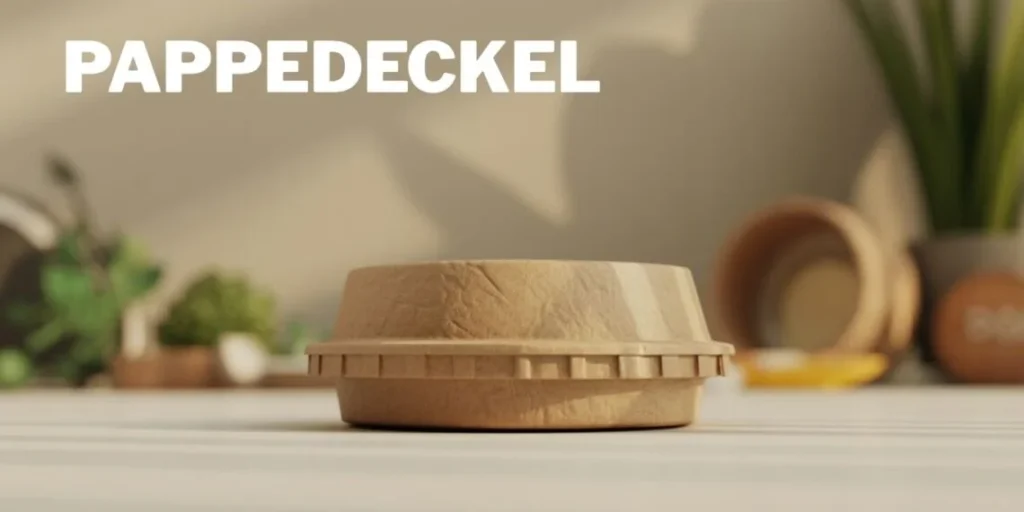In an age where sustainability has become more than a trend, the term “Pappedeckel”—a German word translating to cardboard lid—has gained notable attention. Once considered a simple accessory for coffee cups or packaging, the pappedeckel has evolved into a symbol of environmental consciousness. It represents a small but powerful shift away from plastic waste and toward a greener, more responsible lifestyle. As consumer demand for eco-friendly products grows, pappedeckels have become an essential component in the sustainable packaging movement.
The Origin and Meaning of “Pappedeckel”
The word Pappedeckel comes from the German language, where “Pappe” means cardboard and “Deckel” means lid. Initially, the term referred to any cardboard cover or protective layer used for boxes, containers, or beverages. Over time, it became especially associated with coffee cup lids, beer coasters, and other disposable items made from compressed paper fibers. Germans have long appreciated the practicality and recyclability of such materials, which explains why pappedeckels are deeply integrated into their everyday culture—from cafes to breweries.
A Historical Glimpse: From Coasters to Coffee Lids
Historically, pappedeckels were used primarily as beer coasters. In the 19th century, breweries in Germany started using cardboard coasters to prevent condensation from damaging wooden tables. These early forms were thick, absorbent, and reusable to some extent. As paper manufacturing advanced, lighter and more versatile versions were developed, leading to the modern-day coffee lid and food packaging applications.
In the 20th century, when takeaway culture emerged, pappedeckels gained new relevance. Cafés, bakeries, and fast-food chains began using them for to-go beverages and meals, replacing plastic lids with biodegradable alternatives. Today, these simple lids represent innovation in eco-packaging and reflect a growing awareness of our environmental responsibilities.
Material Composition: What Makes a Pappedeckel Special?
A pappedeckel may look like an ordinary piece of cardboard, but its composition is surprisingly sophisticated. It is usually made from layers of compressed paper pulp derived from recycled fibers. These layers are coated with natural wax or biodegradable polymers to make them moisture-resistant. Unlike plastic, this coating decomposes naturally without leaving harmful residues.
Key components include:
-
Recycled paper pulp: Forms the structural base.
-
Starch or plant-based glue: Used for bonding the layers.
-
Biodegradable coating: Provides protection against liquids and heat.
-
Vegetable-based dyes: Used for branding or coloring.
This combination ensures that pappedeckels are durable, heat-tolerant, and fully compostable, aligning perfectly with modern sustainability goals.
Environmental Benefits: A Step Toward a Greener Planet
The primary appeal of the pappedeckel lies in its environmental benefits. Each use of a cardboard lid instead of plastic prevents non-biodegradable waste from entering landfills or oceans. The positive impact can be summarized in several key areas:
-
Reduction in Plastic Pollution: Every pappedeckel replaces a single-use plastic lid, significantly cutting down on plastic waste.
-
Lower Carbon Footprint: Since they are made from recycled paper, their production emits less carbon than plastic manufacturing.
-
Compostability: Pappedeckels naturally break down into organic matter within weeks, unlike plastic which can take centuries.
-
Resource Efficiency: They are produced from renewable resources, supporting circular economies.
-
Improved Recycling Systems: Many municipalities now include pappedeckels in paper recycling programs, simplifying waste management.
Technological Innovations in Pappedeckel Design
Recent years have seen impressive technological advancements in pappedeckel production. Modern versions are designed not only to be eco-friendly but also to provide a better user experience. Innovations include:
-
Leak-proof sealing edges to prevent spills.
-
Embossed or layered textures for grip and insulation.
-
Custom printing using water-based inks for branding.
-
Hybrid materials combining paper and bio-based plastics for extra strength.
-
Heat-sealing properties for use with hot drinks or soups.
Through innovation, manufacturers have turned a simple cardboard disc into a functional and aesthetically appealing product. Many companies now offer smart lids that include small breathing holes or slots for straws while maintaining full compostability.
The Role of Pappedeckel in the Food and Beverage Industry
The food and beverage industry has embraced pappedeckels as part of its sustainability commitments. Coffee shops, juice bars, and catering services increasingly use them for takeaway packaging. Even multinational chains are replacing plastic lids and trays with cardboard-based alternatives. This shift reflects a broader consumer expectation—people now prefer brands that demonstrate environmental responsibility.
Moreover, the use of pappedeckels supports brand differentiation. Businesses can print logos, slogans, or sustainability messages directly onto lids, turning them into mini billboards that promote eco-conscious values. In this sense, pappedeckels serve both functional and marketing purposes.
Challenges and Limitations of Pappedeckel Adoption
Despite their numerous advantages, pappedeckels face certain challenges in widespread adoption. These include:
-
Moisture Sensitivity: Even with coatings, they may lose integrity when exposed to excessive liquids.
-
Cost Factors: Eco-friendly production can be slightly more expensive than conventional plastic manufacturing.
-
Infrastructure Gaps: Not all regions have proper composting or recycling systems.
-
Consumer Perception: Some users still doubt the durability of cardboard-based lids.
However, ongoing research continues to address these concerns. Companies are experimenting with advanced biodegradable coatings and waterproofing technologies to enhance longevity without compromising sustainability.
Cultural and Social Impact
Beyond functionality, the pappedeckel has become a cultural symbol of environmental responsibility. In Germany and across Europe, using cardboard lids is considered a small act of civic duty—one that collectively leads to large-scale environmental benefits. Events, cafes, and festivals now promote “plastic-free zones,” where pappedeckels and other biodegradable materials are mandatory.
Social media campaigns have further amplified the concept. Photos of beautifully branded pappedeckels circulate widely, linking lifestyle with environmental awareness. In this way, they inspire conscious consumer behavior while reinforcing the idea that small changes create big impacts.
Future Prospects: The Next Generation of Sustainable Packaging
The future of pappedeckels looks promising. As global regulations tighten around single-use plastics, demand for biodegradable alternatives is expected to rise sharply. Companies are investing in biotechnology and material science to create pappedeckels that are even stronger, lighter, and more adaptable.
Emerging innovations may include:
-
Seed-infused lids that can be planted after use.
-
Edible coatings made from natural starches.
-
Smart tracking systems to monitor disposal and recycling rates.
The ultimate goal is to create a closed-loop system where packaging materials are continuously reused or naturally decomposed without environmental harm.
Conclusion: Small Lid, Big Impact
The pappedeckel, though humble in appearance, represents a powerful shift in how society approaches sustainability. Its transition from a simple cardboard cover to an eco-innovation showcases the possibilities of human creativity aligned with environmental ethics. Each lid used in place of plastic contributes to a cleaner planet, healthier ecosystems, and a more responsible global economy.
In the end, the story of the pappedeckel reminds us that sustainability is not always about massive change. Sometimes, it begins with the smallest things—like a cardboard lid that protects your coffee while also protecting the Earth.






